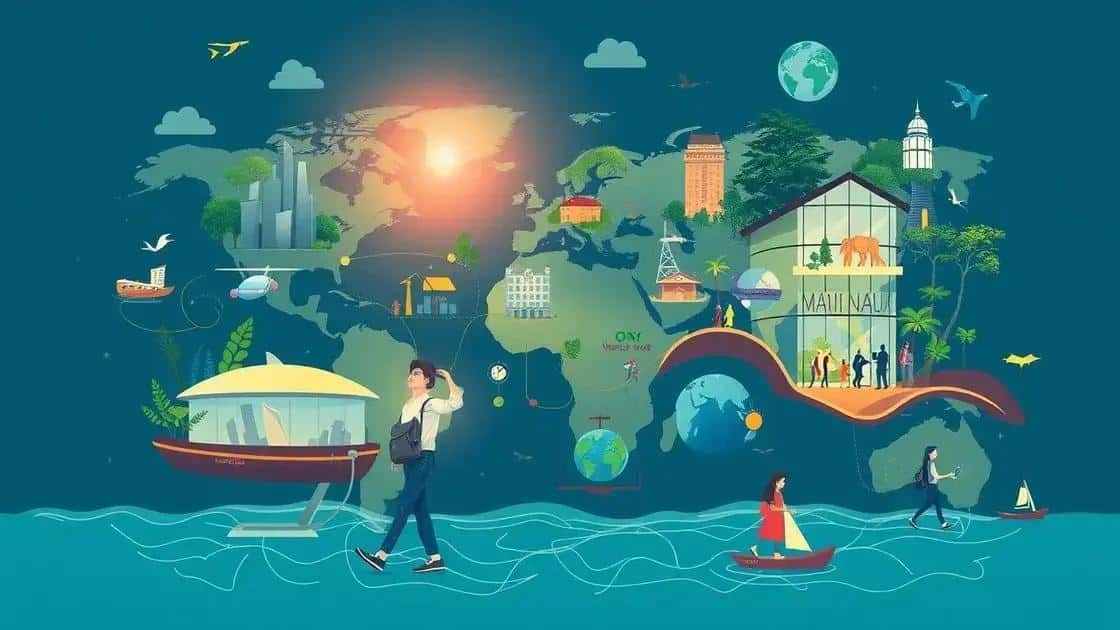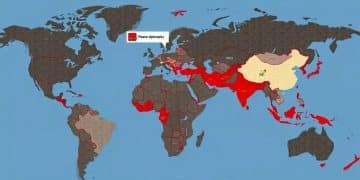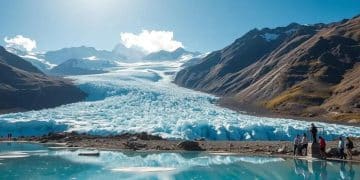Declining demand impacts U.S. international tourism

Anúncios
Declining demand impacts U.S. international tourism due to rising travel costs, health concerns, and shifting preferences towards local experiences, necessitating clear recovery strategies like enhancing safety and promoting sustainability.
Declining demand impacts U.S. international tourism in various ways, leaving many wondering how it will affect travel plans. If you’re curious about the shifts happening, keep reading for insights.
Anúncios
Reasons behind declining demand
The declining demand for U.S. international tourism can be traced to several key factors affecting travelers today. Understanding these reasons helps in grasping the broader implications for the tourism sector.
Travel Costs
One of the primary reasons is the increase in travel costs. Airfare, accommodations, and expenses abroad have risen significantly, leading many potential tourists to reconsider their travel plans.
Anúncios
- Higher airfare rates due to fuel prices
- Increased accommodation costs
- Currency fluctuations affecting buying power
Moreover, economic concerns such as inflation have made many hesitant to spend on international trips. This uncertainty creates a ripple effect across the industry.
Health and Safety Concerns
Health and safety have become paramount in recent years. The pandemic has left lasting fears about traveling, especially in crowded spaces like airports and tourist attractions. Travelers are more cautious now than ever.
Travelers are prioritizing destinations that they feel are safe. Many are opting for local travel, which helps them avoid the potential health risks associated with international travel.
Changing Travel Preferences
Another aspect to consider is the evolving preferences of travelers. Many now seek experiences closer to home rather than lengthy international trips. This trend reflects a shift towards valuing convenience and comfort over exotic destinations.
- Increased preference for domestic tourism
- Advent of remote work enabling local travel
- Desire for shorter, more flexible vacations
As travelers adapt to new norms, destinations must innovate to attract visitors back. The tourism landscape is shifting, presenting challenges and opportunities.
Next, the growing influence of technology has altered how people plan and book their travels. Online platforms provide quick comparisons and easy access, shaping how travelers approach their trips.
Ultimately, identifying the reasons behind declining demand is key to addressing these challenges. The industry must respond strategically to regain momentum and build a healthier tourism sector moving forward.
Impact on U.S. tourism economy

The impact on the U.S. tourism economy is significant due to declining international visitor numbers. With fewer tourists, local businesses face challenges that can ripple throughout the community.
Lost Revenue Opportunities
One of the most noticeable effects is the revenue loss. Businesses that thrive on international tourism, such as hotels, restaurants, and attractions, are feeling the strain. Without these visitors, revenue decreases and jobs can be endangered.
- Hotels experience lower occupancy rates
- Restaurants see a decline in customers
- Local attractions report fewer tickets sold
This situation can lead to cutbacks in staff or even permanent closures if the trends continue.
Impact on Local Employment
Tourism is a major employer in many areas, and a decline in international travelers can lead to job losses. Many locals depend on tourism for their livelihoods. When the demand drops, businesses may reduce their workforce.
The dependencies of local economies on tourism highlight the urgency of promoting recovery strategies. Citizens are not just losing jobs; whole communities face economic challenges that affect their spending power.
Investment Downturn
Another consequence is a slowdown in investments. When the tourism sector struggles, both private and public investments can dwindle. Investors may hesitate to fund new projects, fearing that the returns won’t justify the risks.
- Reduced funding for tourism projects
- Less interest in developing new attractions
- Stalled infrastructure improvements
This creates a cycle that makes recovery even harder, as essential development is put on hold.
Furthermore, international tourism brings cultural diversity and innovation, enriching communities. A decline means fewer opportunities for cultural exchange and a root cause for stagnation in new ideas.
The impact on the U.S. tourism economy extends beyond immediate financial losses. It can degrade community spirit and diminish the unique characteristics that attract visitors in the first place.
Strategies for recovery
Successful strategies for recovery in the tourism sector are essential as the industry adapts to the declining demand for international visitors. It’s important to implement effective methods to regain travelers’ trust and interest.
Enhancing Safety Measures
One way to reassure travelers is to enhance safety measures. Destinations can implement strict health protocols, ensuring guests feel safe during their travels. Clear communication about these precautions can help create a sense of security.
- Increased sanitation in hotels and attractions
- Mandatory health screenings at airports
- Flexible cancellation policies to build confidence
By prioritizing safety, destinations can attract those who are hesitant to travel.
Marketing Targeted Campaigns
Another effective approach is to launch targeted marketing campaigns. Highlighting unique experiences and showcasing local attractions can bring attention back to struggling destinations. Social media is a powerful tool for this purpose, capable of reaching a wide audience quickly.
Creating campaigns that emphasize local culture and hidden gems can lure potential tourists looking for diverse experiences. Engaging storytelling can entice travelers by connecting them emotionally to the destination.
Collaboration with Local Businesses
Collaboration among local businesses can also be a game-changer. By uniting efforts, companies can offer bundled packages that provide value to tourists. This not only supports local economies but also creates memorable experiences for visitors.
- Combining hotel stays with dining experiences
- Offering tours that support local artisans
- Creating events that showcase regional culture
Such initiatives can boost visitor engagement while helping businesses navigate these challenging times.
Finally, adapting to changing traveler preferences is crucial. Understanding what tourists want now can shape new offerings. The rise of eco-tourism and wellness travel has created opportunities for growth. By embracing these trends, destinations can attract a fresh wave of visitors eager for unique experiences.
Future trends in international tourism

The future trends in international tourism are poised to reshape how people travel. Analyzing these trends can provide valuable insights for destinations looking to adapt and thrive.
Rise of Sustainable Tourism
Sustainability is at the forefront of many travelers’ minds. As awareness grows, more people are seeking eco-friendly travel options. Destinations that prioritize sustainability can attract these conscientious travelers.
- Eco-lodges and green hotels are gaining popularity
- Experiences focused on conservation and wildlife protection
- Travelers favoring local cultures and communities
This focus on sustainability encourages a deeper connection to places, benefiting both visitors and hosts.
Digital Transformation in Travel
Technology continues to influence tourism significantly. Tools like mobile apps and online platforms simplify trip planning and booking. Travelers are increasingly relying on digital solutions for a seamless experience.
With the use of virtual reality, potential tourists can preview destinations, creating excitement and engagement before they actually travel. This digital transformation is changing customer expectations significantly.
Health and Safety Innovations
After recent global events, health and safety have become paramount. Future travel will likely see an increase in innovations aimed at providing safer experiences. This includes more contactless services, improved air filtration systems, and health screening technology.
- Contactless check-in and payment options
- Enhanced cleanliness protocols in transport and accommodation
- Real-time health information updates for travelers
Travelers will expect these measures to be part of their journey, making safety a key component of the travel experience.
Moreover, the growing trend of remote work allows people to travel while working. This phenomenon leads to an increase in longer stays in destinations. As digital nomadism grows, countries are embracing this trend by offering specific visa programs.
Understanding these future trends in international tourism is essential for preparing for the evolving landscape. By adapting to these changes, destinations can create strategies that attract a new generation of travelers, promoting both economic growth and sustainable practices.
In summary, the landscape of international tourism is changing rapidly. As demand declines, embracing new trends and strategies becomes crucial for recovery. Focusing on sustainability, leveraging technology, ensuring health and safety, and collaborating with local businesses will be vital to attract travelers back. By adapting to the evolving preferences of tourists, the industry can create a resilient future that benefits everyone involved. The journey ahead may be challenging, but it’s also filled with opportunities for growth and innovation.
FAQ – Frequently Asked Questions about Declining Demand in U.S. International Tourism
What are the main reasons for the declining demand in U.S. international tourism?
The main reasons include rising travel costs, health and safety concerns, and changing traveler preferences, with more people opting for local rather than international travel.
How can destinations recover from the decline in international tourism?
Destinations can recover by enhancing safety measures, launching targeted marketing campaigns, collaborating with local businesses, and adapting to new trends like sustainable tourism.
What role does technology play in the future of tourism?
Technology simplifies trip planning and booking, enhances customer experiences, and enables innovations like virtual reality previews. This is crucial for attracting modern travelers.
How important is sustainability in future travel trends?
Sustainability is becoming increasingly important as travelers seek eco-friendly options. Destinations focusing on sustainable practices can attract this environmentally conscious demographic.






